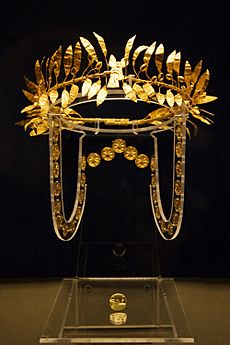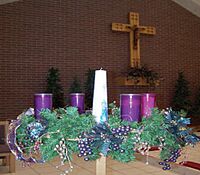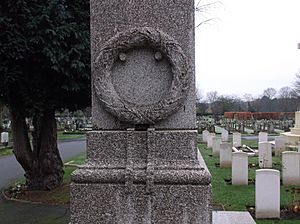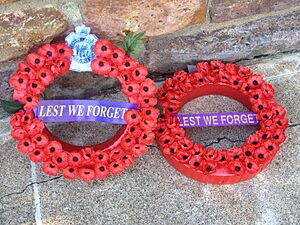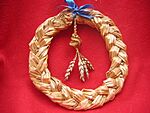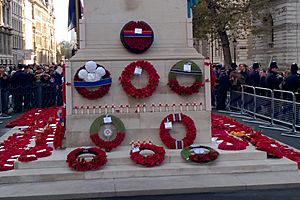Wreath facts for kids

A wreath is a decoration made from flowers, leaves, fruits, twigs, or other materials. It is usually shaped like a ring.
In many countries, people use wreaths as decorations in their homes. They are very common during the Christmas season. Wreaths are also part of special events and ceremonies around the world. Sometimes, people wear them on their heads like a crown or around their necks like a garland.
Contents
What Does the Word "Wreath" Mean?
The word wreath comes from an old English word, writha. This word meant 'band' or 'something twisted'.
A Look Back: History of Wreaths
Ancient Wreaths: Etruscans
Wreaths were popular decorations in ancient times, especially in southern Europe. Some of the most famous early wreaths come from the Etruscan civilization. These were often made of gold or other valuable metals.
Etruscan wreaths sometimes had symbols from Greek myths. Ancient Roman writers described Etruscan wreaths called corona sutilis. These had thin metal leaves sewn onto a band, looking a bit like a diadem. The plants used in these wreaths included ivy, oak, olive, myrtle, laurel, wheat, and grapevines.
Etruscan rulers wore wreaths as crowns. Later, the ancient Greeks and Romans also used wreaths. Roman leaders wore golden wreaths to show their connection to the early Etruscan rulers. They also used other Etruscan symbols like special chairs and purple robes.
Ancient Greece and Rome: Wreaths of Honor
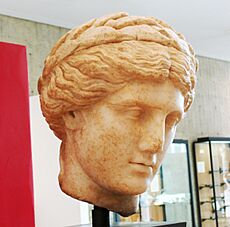
In the ancient Greek and Roman worlds, wreaths showed a person's job, rank, or achievements. The most common was the laurel wreath. This tradition comes from a Greek myth about Apollo, the god of light. Apollo fell in love with a nymph named Daphne. When she ran from him, she asked a river god for help. He turned her into a laurel tree. From then on, Apollo wore a laurel wreath on his head.
Laurel wreaths became a symbol of victory and achievement. They were used to crown winning athletes at the first Olympic Games. Even today, university students in Italy sometimes wear laurel wreaths after they graduate.
Other plants also had special meanings. For example, oak leaves symbolized wisdom. They were linked to Zeus, the king of the gods, who was said to make decisions in an oak grove. Ancient laws from 450 BC mention funeral wreaths as a long-standing tradition. The Olive wreath was the prize for winners at the ancient Olympic Games.
Wreaths Today: Modern Uses
Advent and Christmas Wreaths
In Christianity, wreaths are used during the Advent season. This is a time of preparation for Christmastide (Christmas season) and Epiphanytide (after Christmas). These wreaths are often put up on the first Sunday of Advent.
The Advent wreath started with Lutherans in Germany in the 16th century. In 1839, a Lutheran priest named Johann Hinrich Wichern used a wreath made from a cart wheel. He wanted to teach children about Christmas and help them count down the days. He put a white candle in the wreath for each Sunday of Advent and a red candle for each day in between.
The Advent wreath tradition has spread to many Christian denominations. Most Advent wreaths have four candles. Many also have a white candle in the center, called the Christ candle, which is lit on Christmas Day. Advent and Christmas wreaths are made of evergreens. This represents everlasting life through Jesus. The circular shape of the wreath stands for God, who has no beginning or end.
Advent wreaths are usually placed on stands or tables. Christmas wreaths are often hung on doors or walls. During Advent, some Christians celebrate Saint Lucy's Day. Saint Lucy is said to have used a candle-lit wreath on her head to carry food to Christians hiding in catacombs. On this day, some young Christian girls dress as Saint Lucy, wearing a wreath with candles.
Decorative Wreaths for Homes
Decorative wreaths have ancient roots. In Ancient Greece, they were made from the previous year's harvest, like wheat. They were hung on doors to wish for good crops in the coming year.
Recently, wreaths have become very popular for home decor. People use them all year round, not just for holidays. You can see bright floral wreaths on front doors or simple green wreaths on walls. They are popular because they are versatile and can be customized. It's also easier now to find materials and designs for making your own wreaths. This lets people be creative and make their homes look nice.
Corpus Christi Wreaths
On the day before the Feast of Corpus Christi, Christian leaders bless special wreaths made of flowers. These wreaths and flower bouquets are often attached to flags, banners, houses, and arches over streets. In Christian homes, these wreaths are hung on walls or displayed in windows. Corpus Christi wreaths are also placed in gardens and fields. This is done with a prayer for protection and blessings on the growing crops.
Wreaths for Funerals and Memorials

Wreaths have been used at funerals since ancient Greek times. They represent a circle of eternal life. Evergreen wreaths were placed at the burial sites of early Christian martyrs. The evergreen symbolized the spirit's victory over death.
In old England, there was a custom for funerals of young women. A young woman of the same age would lead the funeral procession. She carried a wreath of white flowers. This showed the purity of the person who died and the "eternal crown of glory" waiting for her in heaven.
By the Victorian era, flowers had special meanings. Funeral wreaths used specific flowers to show different feelings. Cypress and willow were used for wreath frames. They were linked to mourning.
Today, wreaths are often placed at the graves of soldiers and at memorial sites. This happens during ceremonies like Memorial Day and Remembrance Day. Wreaths can also be placed in the sea to remember people lost at sea. In a sea memorial, the wreath is gently lowered into the water. Funeral wreaths sometimes have a "wreath sash." This is a decorated ribbon that remembers a life or sacrifice. This tradition continues today, and sashes are also used on wreaths for holidays.
Harvest Wreaths
Harvest wreaths are common home decorations today. This custom has ancient roots in Europe. In Ancient Greece, the harvest wreath was a sacred charm. It was made of wheat or other harvested plants, woven with red and white wool. The harvest wreath would hang by the door all year.
Harvest wreaths were important to the community in Ancient Greece. Festivals for Dionysus included a ritual procession. Young boys carried a harvest wreath and sang. The laurel or olive wreath was hung at the door. People hoped this ritual would protect against bad harvests and diseases.
In Poland, the harvest wreath (wieniec) is a main symbol of the Harvest Festival, Dozynki. Wreaths are made in different shapes and sizes using harvested grains, fruits, and nuts. The wreath is then taken to a church for a blessing. The tradition includes a procession from the church to the family home. A girl or young woman leads the procession, carrying the wreath. A celebration and feast follow.
Wreaths Worn as Crowns
A wreath can be a headdress made from leaves, flowers, and branches. People often wear them for celebrations and holy days. Wreaths were first used in pagan rituals in Europe. They were linked to the changing seasons and fertility. Later, Christianity adopted the wreath's symbolism, connecting it to honor and good values. In the Middle Ages, Christian art showed the Virgin Mary and saints wearing wreaths, just like ancient Roman and Greek heroes.
Maypole Wreaths
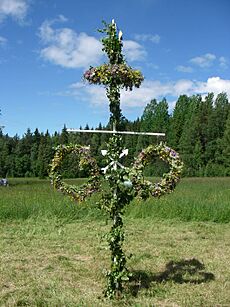
Wreath customs have lasted for centuries in Europe. In England, May Day celebrations include Maypole festivities. Young unmarried men race to climb to the top of the Maypole to grab the May Day wreath. The winner wears the wreath as his crown and becomes the May Day King for the day.
Plants used for Midsummer wreaths include white lilies, green birch, fennel, St. John's Wort, wormwood, vervain, and flax. The flowers had to be picked early in the morning before the dew dried. People believed that the plants' magic disappeared with the dew. Midsummer celebrations with Maypoles and wreaths are still popular in Germany and Scandinavia.
Wreath Symbolism in England
By the Renaissance period, wreaths in England became symbols of political and religious groups. Protestant reformers, like the Puritans, thought wreaths and holidays like May Day were pagan. They believed these traditions harmed Christian values. Soldiers even took away wreaths in Oxford in 1648.
After King Charles I of England was overthrown, wreaths became a symbol for those who supported the king. When Charles II of England was crowned, a procession in Bath included 400 young women. They carried "gilded crowns, crowns made of flowers, and wreaths made of laurel mixed with tulips."

Saint Lucy's Day Crown
Saint Lucy is often shown in Christian art wearing a wreath as a crown. The wreath has lit candles, symbolizing the light of the world, which is Christ. Sweden has a long history of celebrating Saint Lucy's Day (St. Lucia's Day). "St. Lucia's crowns," which are brass wreaths holding candles, are part of the customs for this holiday.
Wreath Laying Ceremonies
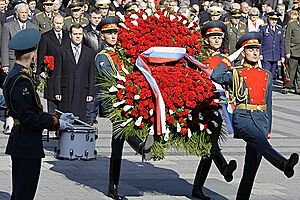
A wreath laying ceremony is a tradition where wreaths are placed at a grave or memorial site. It is a formal way to show respect. Important people, like heads of state, often take part in these ceremonies. After placing the wreath, the person steps back and bows or salutes the memorial. During military wreath laying ceremonies, bugle calls like "Last Post" or "Taps" are played.
In the Netherlands, wreath laying (Dutch: Kranslegging) usually happens on National Remembrance Day, May 4. During visits by foreign leaders, a wreath is laid at the National Monument in Amsterdam.
In Russia, it's a tradition to lay wreaths at war memorials on special military holidays, like Defender of the Fatherland Day and Victory Day. A very important ceremony takes place at the Tomb of the Unknown Soldier in Moscow. The President of Russia, the Prime Minister of Russia, and other important people lay a wreath near the eternal flame. A moment of silence follows, often with a solemn march by an honour guard.
In the United Kingdom, wreaths are famously laid at the Cenotaph during the National Service of Remembrance on Remembrance Day.
|


